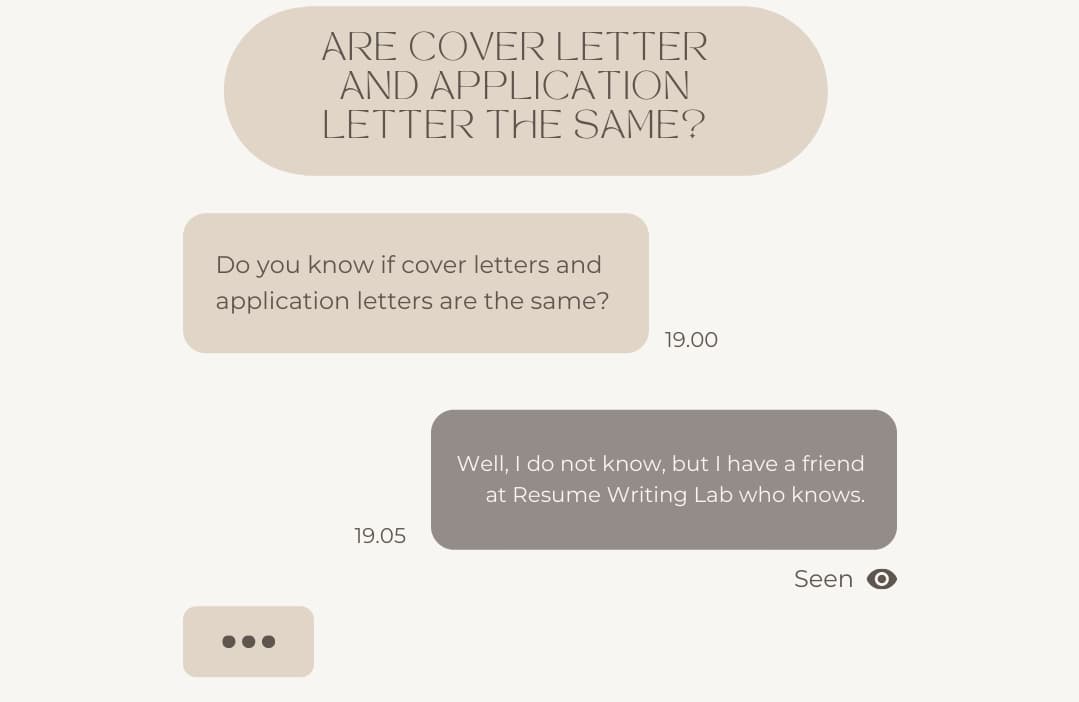- How it Works
- Privacy Policy
- Terms of Service
- IT/Software Development
- Banking/Finance/Insurance
- Education/Academia
- Healthcare/Medical Services
- Mining/Natural Resources
- Manufacturing/Electronics
- Retail/Sales/Ecommerce
- Hospitality/Tourism/Airline
- Construction/Real Estate
- Energy/Utilities
- Professional Corner
- For Employers
Search jobs here…

What is the difference between application letter and cover letter? FREE TEMPLATE

General | 11 Sep 2023
In the competitive job market of today, job seekers are constantly on the lookout for ways to stand out and make a positive impression on prospective employers. Two essential tools in the job hunting arsenal are the application letter and the cover letter. While these terms are often used interchangeably, they serve distinct purposes in the hiring process. In this comprehensive guide, we will explore the key differences between application letters and cover letters, and provide step-by-step instructions on how to create both effectively.
What is an Application Letter?
An application letter, also known as a job application letter or a letter of application, is a formal document submitted by a job seeker to express their interest in a specific job vacancy. The primary purpose of an application letter is to introduce the applicant and their qualifications to the potential employer. Unlike a resume or CV, which provides a comprehensive overview of one's professional history, an application letter is tailored to a particular job opening.
Also read How to Create a Comprehensive Resume
How to Create an Application Letter
1. research the job opening.
Before you begin crafting your application letter, it's crucial to thoroughly research the job opening. This includes understanding the job requirements, responsibilities, and the company's culture. The more you know about the position, the better you can align your qualifications and skills with the employer's needs.
2. Format and Structure
An application letter should follow a standard business letter format. Here's a basic structure to follow:
Heading: Include your contact information (name, address, phone number, and email) at the top, followed by the date.
Recipient's Information: Below the date, include the recipient's name, title, company name, and address. If you can't find this information in the job posting, address the letter to the hiring manager.
Salutation: Start your letter with a professional salutation, such as "Dear Mr. Smith" or "Dear Hiring Manager."
Introduction: Begin with a strong opening paragraph that mentions the specific job you're applying for and how you learned about it. Express your enthusiasm for the position.
Body Paragraph(s): Use one or more paragraphs to highlight your qualifications, skills, and relevant experiences. Be specific and provide examples of how your background aligns with the job requirements.
Closing Paragraph: Summarize your interest in the position and express your desire for an interview. Mention that you have attached your resume for reference.
Closing : Use a formal closing such as "Sincerely" or "Yours faithfully," followed by your signature and typed name.
3. Tailor Your Letter
Each application letter should be customized for the specific job you're applying for. Highlight the qualifications and experiences that make you an ideal candidate for that particular position. Avoid using a generic, one-size-fits-all letter.
4. Showcase Your Skills
Use the application letter to showcase your skills and experiences that are most relevant to the job. Highlight achievements, projects, or experiences that demonstrate your capability to excel in the role.
Also read 7 Interview Tips to Impress Hiring Manager
5. Proofread and Edit
Before sending your application letter, carefully proofread it for grammar, spelling, and formatting errors. A well-written, error-free letter demonstrates professionalism and attention to detail.
6. Enclose Required Documents
If the job posting specifies additional documents, such as transcripts, certifications, or writing samples, make sure to include them along with your application letter.
When to Use an Application Letter
Application letters are typically used when:
A job vacancy is advertised.
The employer specifically requests an application letter.
You want to provide a more personalized introduction to your resume.
Effective Application Letter Example:
[Your Name]
[Your Address]
[City, State ZIP Code]
[Your Email Address]
[Your Phone Number]
[Today's Date]
[Recipient's Name]
[Recipient's Title]
[Company Name]
[Company Address]
Dear [Recipient's Name],
I am writing to apply for the [Position Name] at [Company Name], as advertised on [Where You Found the Job Posting]. With my strong background in [Relevant Skill/Experience], I am excited about the opportunity to contribute my expertise to your team.
In my current role at [Current Company], I have consistently demonstrated my proficiency in [Relevant Skill]. For instance, [Provide an Example of an Achievement or Project Relevant to the Position]. These experiences have honed my abilities and prepared me for the challenges and responsibilities of the [Position Name] role at [Company Name].
What sets [Company Name] apart for me is its reputation for [Company Attribute or Project]. I am deeply impressed by the impact your organization has made in [Industry or Field], and I am eager to be part of such an innovative and forward-thinking team.
Please find my resume attached, which offers a more comprehensive overview of my qualifications. I am enthusiastic about the opportunity to discuss how my skills can contribute to the continued success of [Company Name].
I can be reached at [Your Email Address] or [Your Phone Number]. Thank you for considering my application. I look forward to the possibility of becoming a part of the [Company Name] family and working toward achieving its goals.
What is a Cover Letter?
A cover letter, sometimes referred to as a covering letter, is a document that accompanies your resume when applying for a job. Unlike an application letter, which is typically focused on a specific job vacancy, a cover letter is more general and can be used for various job applications. The primary purpose of a cover letter is to introduce yourself, highlight your qualifications, and explain why you are an excellent fit for the company as a whole.
How to Create a Cover Letter
1. research the company.
Before you start writing your cover letter, research the company you're applying to. Understand its values, mission, culture, and recent achievements. This knowledge will help you tailor your cover letter to align with the company's goals and values.
A well-structured cover letter should include the following elements:
Heading : Similar to an application letter, include your contact information and the date at the top.
Recipient's Information : Address the letter to the hiring manager or the appropriate person if their name is mentioned in the job posting. If not, use a generic salutation like "Dear Hiring Manager."
Introduction : Begin with a strong opening that mentions the position you're interested in and how you found out about it. Express your enthusiasm for the company and explain why you're a good fit.
Body Paragraphs : Use one or more paragraphs to showcase your qualifications, skills, and experiences. Emphasize your contributions and achievements in previous roles. Highlight how your skills align with the company's needs.
Closing Paragraph: Summarize your interest in the company and reiterate your enthusiasm for the position. Express your desire for an interview to further discuss your qualifications.
Closing : Use a professional closing, such as "Sincerely" or "Best regards," followed by your signature and typed name.
3. Personalize Your Cover Letter
While a cover letter can be more general than an application letter, it should still be personalized for the specific company and position. Tailor your content to match the company's values and show how you can contribute to its success.

4. Highlight Transferable Skills
In a cover letter, focus on transferable skills that are applicable across various roles and industries. Explain how your diverse skill set makes you adaptable and a valuable asset to the company.
5. Match Your Resume
Your cover letter should complement your resume, not duplicate it. Use the cover letter to provide context for your resume and highlight specific achievements or experiences that are relevant to the job.
6. Proofread and Edit
Just like with an application letter, proofread and edit your cover letter carefully to ensure it is error-free and well-written. Attention to detail is crucial.
When to Use a Cover Letter
Cover letters are typically used when:
You are applying for a job without a specific job posting.
The job application process requires a cover letter.
You want to express your interest in a company and its culture, beyond a specific job opening.
Apply to urgently hiring jobs here!
Effective cover letter example.
I am writing to express my strong interest in the [Position Name] position at [Company Name], as advertised on [Where You Found the Job Posting]. With a proven track record in [Relevant Skill/Experience], I am confident that my qualifications align perfectly with the requirements of this role.
In my previous role at [Previous Company], I [Briefly Describe an Achievement or Responsibility Relevant to the Position]. This experience allowed me to hone my [Relevant Skill] skills and contribute to the growth and success of my team. I am eager to bring this expertise to [Company Name] to contribute to its continued excellence.
One of the aspects of [Company Name] that particularly excites me is [Specific Company Attribute or Project]. Your commitment to [Company's Values or Mission] aligns perfectly with my own professional values, making [Company Name] a natural fit for my career goals.
Enclosed is my resume, which provides further details about my qualifications. I would welcome the opportunity to discuss how my skills and experiences can benefit [Company Name] in greater detail. Please find my contact information below:
Thank you for considering my application. I look forward to the possibility of joining the team at [Company Name] and contributing to your ongoing success.
In conclusion, application letters and cover letters serve distinct purposes in the job application process. An application letter is tailored to a specific job vacancy and focuses on your qualifications for that role, while a cover letter is more general and introduces you to the company as a whole. Both letters, however, are essential tools for showcasing your skills and enthusiasm to prospective employers.
To succeed in your job search, it's crucial to create both types of letters effectively. Research the job opening or company thoroughly, follow the appropriate format and structure, and customize the content to match the employer's needs. Additionally, always proofread and edit your letters to ensure they make a positive impression. Application letter example and cover letter example illustrate how to structure both a cover letter and an application letter effectively, emphasizing the importance of tailoring the content to the specific job and company while showcasing your qualifications and enthusiasm.
By understanding the differences between application letters and cover letters and mastering the art of creating them, you can increase your chances of landing your dream job in today's competitive job market.
Related Insights

Customer Service Job Interviews: Common Questions and How to Answer Them
26 Oct 2023

11 Sep 2023

Smart and Best Answers for Reason for Career Change in Interview
08 Sep 2023
Job seekers.
- Jobs by Company
- Jobs by City
- Career Advise
- Testimonials
- Search for Resumes
- Advertise with us
About Jobyoda
- Follow Us On
Copyright JOBYODA©2022. All Rights Reserved

Enter Your Details Below to
Claim Your Venti Coffee Gift Voucher
Enter your details, which company did you get hired at, successfully submitted.
We will validate your hiring details with our partners and process your voucher shortly
Enable Location Services

JOBYODA need access to your location to enhance your experience. Allow access to get personalized jobs , companies and recommendation jobs. To enjoy all that JOBYODA has to offer, turn on your GPS
Are Cover Letter and Application Letter the Same?

While cover and application letters are usually used in the same contexts, every job seeker has to know the significant differences between these two documents.
Nowadays, application and cover letters are sent via email, so, it’s also important to familiarize oneself with the writing trends and standards of online documents.
So, What’s the Difference?
The main difference between applications and cover letters are:
- Application documents are considered to contain in-depth information about candidate skills and qualities while cover letters are merely used for submitting the documents.
- Cover letters carry out simpler functions and only define your professional capacity as a sender, a recipient, and the purpose of the letter. Application letters perform three main functions: to draw the attention of the potential recruiter, to reflect you as the perfect fit for the position, and to secure the interview.
- Application letters highlight qualifications, skills, strengths, and previous jobs to which this information should relate to the job applied. Done properly, it will showcase you as a good fit for the position. A cover letter can omit specific details, though it must include contact information and motivate why you’re applying for the position and why you’re good for it.
- Cover letters are shorter as they don’t include detailed information. Applicant documents shouldn’t exceed one page. In terms of improving career opportunities, wherever possible your letter should consist of three paragraphs in which you introduce yourself and your objective in the first paragraph. You should present your strengths in the second paragraph and propose an interview in the third paragraph.
- Cover letters aren’t considered the decisive element of an application package. Application letters usually accompany resumes in most cases, as they can offer more about your professional candidacy. Or you can always check some of the best companies that will help you with writing your cover letter on Linkedin .


IMAGES
VIDEO
COMMENTS
Learning the differences between an application letter and a cover letter may help you decide the best way to express your interest in a position. In this article, we discuss what an application letter and cover letter are, then explain how both letters differ from one another.
In this article, we discuss the definition of an application and cover letter, highlight the differences between application and cover letters, and provide samples of introductions and work histories for these letters.
In this article, we are discussing the difference between a cover letter vs. an application letter. Both are used to introduce yourself, demonstrate your qualifications, and convince the employer to call you for an interview.
The differences between an application letter and a cover letter. To summarize, while the application letter is a mash-up of a resume and a cover letter, it is a little more than that. Essentially candidates use it as an extended conversation starter in certain specific situations.
An application letter is tailored to a specific job vacancy and focuses on your qualifications for that role, while a cover letter is more general and introduces you to the company as a whole. Both letters, however, are essential tools for showcasing your skills and enthusiasm to prospective employers.
The main difference between applications and cover letters are: Application documents are considered to contain in-depth information about candidate skills and qualities while cover letters are merely used for submitting the documents.